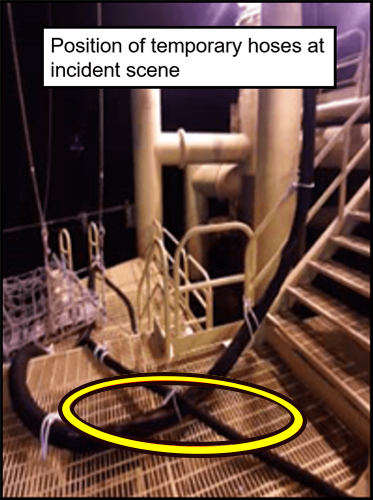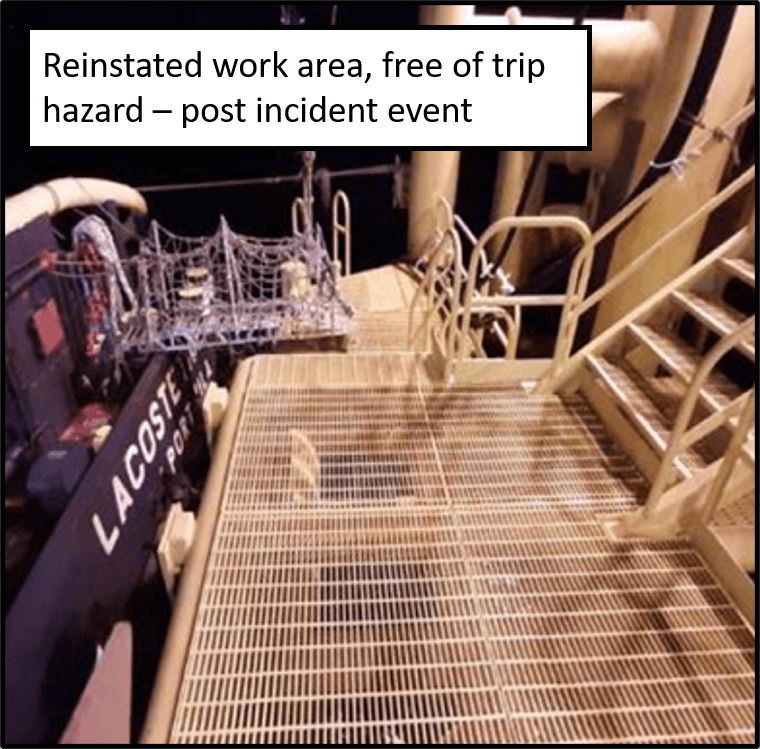-
What happened?
When descending stairs on an offshore platform, an employee tripped over a 2-inch discharge hose that had been laid across the base of a stairway.
He fell between the boat landing and moored workboat, braking his fall by grabbing a fender chain attached to the workboat.
The officer on watch witnessed the incident from the vessel bridge and raised the alarm. He was manually recovered to deck.
He was wearing a three-piece foam floatation device, and all required personal protective equipment (PPE) including a helmet with chinstrap correctly worn.
The crew member was injured. There was potential for the outcome to be more severe.

-
Why did it happen?
Poor hose management practices: hoses were laid across the platform boat-landing causing a trip hazard.
Control measures as per the approved risk assessment were not implemented: specifically, the requirement to route hoses in a safe manner.
Laying hoses on platform walkways had been common practice.
Individuals accessing the platform’s boat landing had failed to recognise and report the hazards.

-
What did they learn?
Ensure all work tasks are adequately planned and risk assessed before starting work activities, including review of access, egress and escape routes.
Where temporary hoses are placed at access ways/work areas, always consider additional controls to eliminate the possibility for trip hazards, such as use of cable racks or hose covers.
Increase focus on critical safety behaviours such as ‘eyes on path’ when accessing unfamiliar worksites.
When hazards and/or unsafe conditions are observed, intervene and report.

-
Ask yourself or your crew
How can something like this happen here?
What hazards have you witnessed that could have led to severe injuries?
How do we report hazards?
How can we practice good hose management?
What are our man overboard (MOB) procedures?

Add to homescreen
Content name
Select existing category:
Content name
New collection
Edit collection
What happened?
When descending stairs on an offshore platform, an employee tripped over a 2-inch discharge hose that had been laid across the base of a stairway.
He fell between the boat landing and moored workboat, braking his fall by grabbing a fender chain attached to the workboat.
The officer on watch witnessed the incident from the vessel bridge and raised the alarm. He was manually recovered to deck.
He was wearing a three-piece foam floatation device, and all required personal protective equipment (PPE) including a helmet with chinstrap correctly worn.
The crew member was injured. There was potential for the outcome to be more severe.

Why did it happen?
Poor hose management practices: hoses were laid across the platform boat-landing causing a trip hazard.
Control measures as per the approved risk assessment were not implemented: specifically, the requirement to route hoses in a safe manner.
Laying hoses on platform walkways had been common practice.
Individuals accessing the platform’s boat landing had failed to recognise and report the hazards.
What did they learn?
Ensure all work tasks are adequately planned and risk assessed before starting work activities, including review of access, egress and escape routes.
Where temporary hoses are placed at access ways/work areas, always consider additional controls to eliminate the possibility for trip hazards, such as use of cable racks or hose covers.
Increase focus on critical safety behaviours such as ‘eyes on path’ when accessing unfamiliar worksites.
When hazards and/or unsafe conditions are observed, intervene and report.

Ask yourself or your crew
How can something like this happen here?
What hazards have you witnessed that could have led to severe injuries?
How do we report hazards?
How can we practice good hose management?
What are our man overboard (MOB) procedures?
Crew member tripped on a 2-inch discharge hose that had been laid across the base of a stairway.











